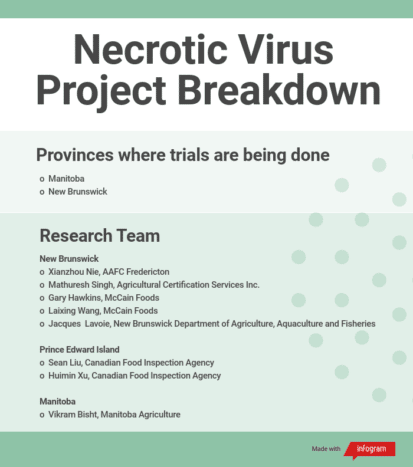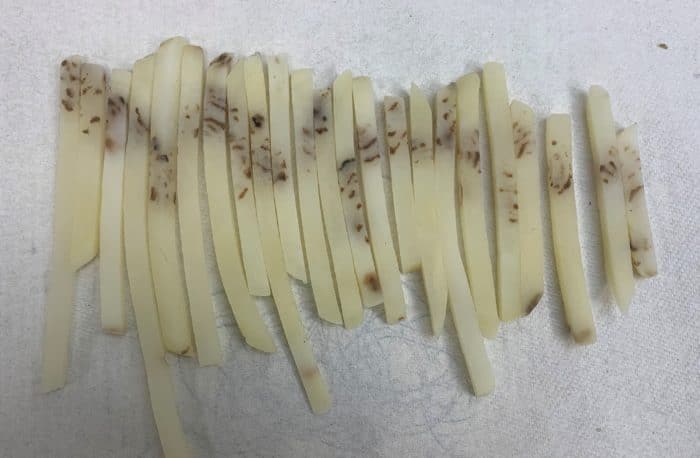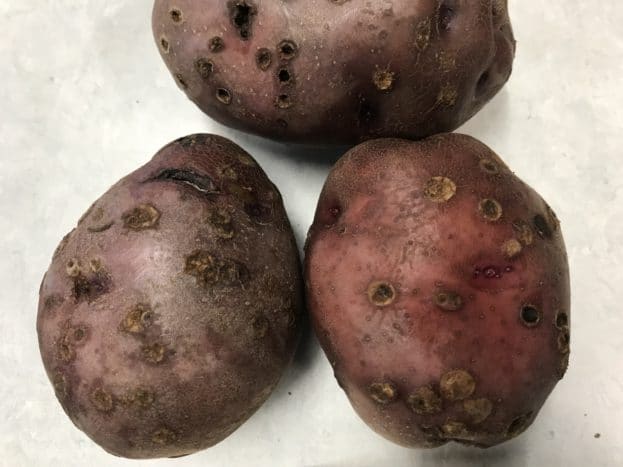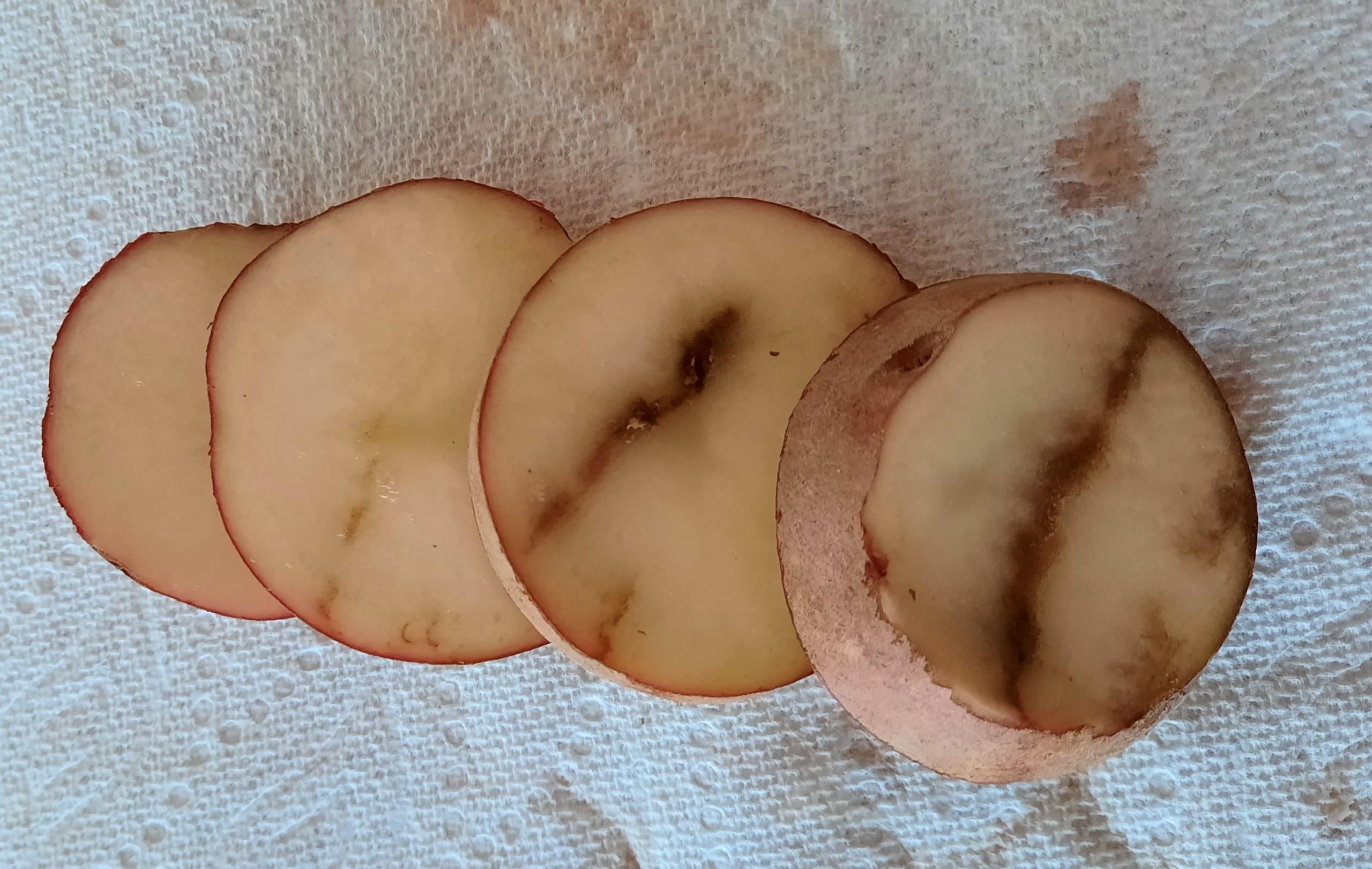While potato necrotic viruses won’t break the bank, they’re costly for the industry and a group of researchers have found ways to find them faster saving growers money.
Necrotic viruses in potatoes cover a wide range of viruses. Some cause symptoms on foliage while others damage tubers — internal or external. These viruses may not cause harm to humans or completely wipe out potato crops, but they can still cause problems and affect profits at the end of the day.
There’s still not much known on management practices or even how to identify different necrotic viruses. However, as part of a research project led by Xianzhou Nie, a research scientist at Agriculture and Agri-Food Canada (AAFC) Fredericton Research and Development Centre (FRDC), he has been taking a closer look at potato tuber necrosis-inducing viruses, including identifying strains in Canada, and finding a better way to identify those strains.
“First of all, is whether the plant can be infected — has a sensitivity to the virus infection. The second one we care more about is sensitivity to the virus induced symptoms,” Nie explains in a phone interview.
The project started in 2018 and lasts for five years. It’s part of the Canadian Potato Council with the Canadian Horticultural Council cluster projects funded by the Canadian Agricultural Partnership (CAP).
Nie has been working on necrotic viruses for the past two decades, first starting with his post-doctoral work at FRDC. When the Canadian Potato Council was looking for research project proposals, necrotic viruses was identified as an area of interest with Nie in New Brunswick leading the charge. He has worked with Vikram Bisht, a plant pathologist agronomist with Manitoba Agriculture, to try and find ways to help growers with necrotic viruses in both Manitoba and New Brunswick.

Potato Necrotic Viruses in Canada
While there are a few tuber necrotic viruses in the world, as part of the project Nie and his team focused on four different ones known to be in Canada — potato virus Y (PVY), alfalfa mosaic virus (AMV), tobacco rattle virus (TRV) and potato mop-top virus (PMTV).
AMV has a wide host range and can infect more than 150 species of 22 plant families, with potato being one. It was previously called potato calico virus as it causes bright yellow blotching or mottling on leaves. AMV infections are usually minor in potato crops with it not impacting potato production costs significantly. Nie first heard of it in 2015 when AMV was identified as causing severe internal necrosis in tuber samples from New Brunswick.
PMTV is a soilborne virus that can cause severe tuber disease called spraing — indicated by internal necrotic arcs or rings in infected potato tubers. Diseased tubers lose market value, causing significant economic losses when disease incidence is high. It was first reported in North America in 2003, with numerous reports in the U.S. and Canadian having happened since then. Due to the soilborne nature of PMTV, controlling it is challenging.
“PMTV survives in the soils for many, many years on virus infected scab fungus. PMTV can infect any of the solanaceous weeds also, but it is more important for the potato crop,” Bisht explains in a phone interview. It can also be spread from field to field on machinery. Crop rotations are important to combat the disease.
“What do you plant? Other crops than the potatoes, because potatoes are going to have a lot of disease, you can do that only for so long,” he adds. “The other alternatives is grow something which will resist expression of the disease. It will reduce the losses, even if the virus is present in the tubers.”

Potatoes with skin defects caused by powdery scab and common scab are graded out at higher levels from the fresh industry. In the processing industry these scab diseases increase the time needed to peel the potatoes for use.
PMTV can also cause problems in storage. Brown striations in the tubers, will appear after being in cold storage and get worse the longer the potatoes are in storage. Bisht explains infected tubers are found during processing making them unable to be used in some incidences.
Identifying Potato Necrotic Viruses
As part of Nie’s research on AMV, he was able to find four AMV susceptible potato cultivars to test. AMV was inoculated into the cultivars, Innovator, Yukon Gold, Rochdale Gold-Doree and Shepody, which then developed tiny necrotic spots and calico symptoms on new leaves. The other cultivars tested only showed calico symptoms on new leaves.
Huimin Xu with the Canadian Food Inspection Agency in Prince Edward Island collected several AMV isolates/strains which were then studied along with the isolate from New Brunswick. Despite the differences in genetics, there were similar levels of internal necrosis produced in the tubers of Innovator and its parent Shepody from all AMV isolates. These results show the amount of internal necrosis in AMV-infected tubers depends on potato cultivar rather than AMV strain.
PMTV on the other hand is a soilborne disease making soil detection of it imperative. In the past this has been done through bait plants along with enzyme linked immunosorbent assay (ELISA), or with reverse transcription (RT)-polymerase chain reaction (PCR).

In Nie’s first study PMTV was detected using the bait plant test. Tobacco plants used as bait were grown in soil from potato fields where PMTV or Spongospora subterranea f. sp. Subterranea (Sss)-infected tubers had been found. The bait plants were then tested for PMTV using RT-PCR analysis.
Nie and his team were able to develop a procedure called high resolution DNA melting (HRM) assay for detection of both PMTV and its protist vector, Sss, from soil directly. When the test was used on soil samples from fields across New Brunswick where PMTV or Sss infected tubers had been found, PMTV or Sss was found in 63 to 100 per cent of samples. Samples from fields with no infected tubers, were found to have no PMTV or Sss discovered.
Previous tests had required the bait plant to be tested for PMTV infection, with Nie’s teams’ findings the soil in a suspected infected field can be tested now instead, making for a faster diagnosis.
Header photo — Cut potato tubers with potato mop-top virus (PMTV) internal necrotic symptoms. Photo: Xianzhou Nie
Related Articles
Using Photos to Find Potato Diseases in Plant Leaves
Revisiting the Impact of Heat Stress on Potatoes
Potato Virus Y is the Most Serious Threat to Potato — Some Strains More than Others









